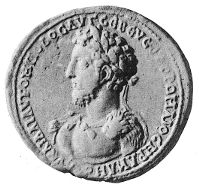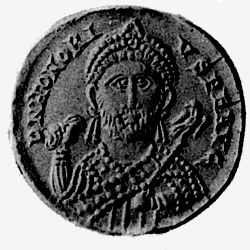Roman Empire Facts
"When you are at Rome, live in the Roman style; when you are elsewhere, live as they live elsewhere."
—St. Ambrose
35 results found. Go to page:
1 2 The Circus Maximus in Rome, after its rebuilding by Julius Caesar, could accommodate 150,000 people. It was enlarged again in the days of the early empire to admit an additional 100,000. (source)
Vergil, who is generally accepted as the greatest of the Roman poets, left instructions that, upon his death, his manuscript of the Aeneid should be burned because he had not been able to polish it. Roman emperor Augustus—who may have been the one who requested Vergil to write it—stepped in and countermanded Vergil's request. He had others polish the work, and ordered it published.
Though only a child, Gaius Caesar, son of the famous Roman general Germanicus (15 B.C.–19 A.D.) and his wife, Agrippina, travelled with his parents among the legions of Rome, and was wildly popular. The soldiers nicknamed him Caligula, or "Little Boots," and the sobriquet stuck with him right through the last unbalanced years of his sordid life. Caligula (12–41 A.D.) became Emperor of Rome (37–41) and earned a reputation for ruthless cruelty, torture, and execution. He became so hated that he was assassinated by one of his own guards.
According to Roman historian Suetonius, it was rumoured that one consul and coregent of Rome was a horse—Emperor Caligula's favourite, Incitatus, who was accorded honour at every turn. Caligula's successor, Claudius, did not invite Incitatus in to dine, as had Caligula, but the horse was still decently treated, having an ivory manger and a golden drinking goblet for partaking of wine. (source)
The first volume of recipes was published in 62 A.D. by the Roman Apicius. Titled De Re Coquinaria, it described the feasts enjoyed by the Emperor Claudius. (source)

Coin depicting Nero.
Roman Emperor Nero's last words were "Qualis artifex pereo"—roughly, "What an artist dies in me". (source)
View more facts about:
Lasts During the hundred days of the opening games at the Colosseum in Rome, in 80 A.D., over 5,000 animals were killed, including elephants, tigers, lions, elks, hyenas, hippopotamuses, and giraffes. (source)
![The Colosseum in Rome [The Colosseum]](/images/colosseum.jpg)
The Colosseum.
Modern archaeologists have not yet agreed on how large a crowd the Colosseum in Rome could hold in its glory days. One authority estimates 50,000, but around 45,000 is the generally accepted figure. (source)
At the height of the Roman Empire in the second century, its area was approximately equal to that of the United States today. The population was at least 70 million and might have been more than 100 million. Over one million people lived in the city of Rome itself. There were over 18,000 miles of roads in the empire.
When the Romans built Hadrian's wall, they built a moat, not only around the outside of the wall, but also around the inside, at a cost of a million days' labour. The exact purpose of the inside moat has never been determined. Only a few years after building it, the Romans decided to fill it in.

Coin depicting Commodus.
Commodus (161–192), emperor of Rome (180–192), fought and won 1,031 battles in the gladiatorial arena.
One of the worst Roman emperors was Heliogabalus. Born around the year 203, he was the high priest at the pantheon of the deity Heliogabalus. In 218, largely due to the scheming of his mother, Heliogabalus became emperor of Rome. He was a practical joker, a spendthrift and a gourmand. He never gave a banquet that cost less than 100,000 sesterces (about $10,000), and often he would pay up to 3,000,000 sesterces. Furthermore, he ignored the ancient gods of Rome and replaced them with the Syrian customs familiar to him. The residents of Rome were offended by many of the eastern rites, which they felt to be obscene. Heliogabulus was assassinated in 222. (source)
One of the many causes of the decline of the Roman Empire may have been their use of slave labour. While the ancient Greeks had many impressive scientific and mathematical achievements, they never succeeded in applying any of their discoveries to any practical use, in part because slave labour was cheap and readily available. By the end of the second century A.D., the ancient world's lack of industrial technology and labour-saving machines began to make it difficult for the Roman Empire to maintain both its military and a healthy civilian population.
Around the end of the fourth century, about 20 great families in six large clans owned most of the land in Gaul (modern-day France) and Italy. (source)
When the Roman Empire "fell" in the fifth century, it was only the Western half that actually fell. The Eastern half, which would later become known as the Byzantine Empire, survived the fifth century intact, and would last for almost a millennium more, until Constantinople was captured by the Turks in 1453. (source)
It was sheer force of numbers, not superior technology and skill, that eventually overcame the Romans. Though the Romans tried (often successfully) to absorb the Germanic and other "barbarian" tribes surrounding the empire, it succumbed to a combination of internal decay and tremendous external pressures.

Coin depicting Honorius.
The Italian city of Ravenna was once an important port on the coast of the Adriatic Sea. Emperor Honorius made it the capital of the Western Roman Empire in the year 402 because of its strategic location, being surrounded by marshes and virtually inaccessible by land, while having a major port, Classis. Today, Ravenna is no longer a port, being five miles from the sea. Sand and silt have been deposited by the River Po from the plains of Lombardy and a sand bar has been created by sea currents, burying the harbour and forming new land beyond it. (source)
Roman Emperor Theodosius II built a triple wall from the Golden Horn to the Sea of Marmara, fortifying the landward side of Constantinople with a very strong barrier. The walls took over 30 years to build, being built between 413 and 447. On the far side of the defenses was a moat, sixty feet wide and twenty-two feet deep, which the enemy would have to cross in order simply to reach the first wall. Behind the low first wall, crouching archers could securely pick off attackers. If the moat was passed and the first wall breached, there were two additional walls: the middle wall was twenty-seven feet tall, and the third wall was seventy feet tall; from the third, the defenders could shoot their arrows and catapult their stones. These walls protected Constantinople from invasion for a millennium, until 1453, by which time a new invention, the cannon, could pierce the walls. The ruins are still impressive over 1,500 years later. (source)
The word "mile" comes from the Roman milia, "thousands". The Romans measured distances in paces (from left foot to left foot; we would regard these as double paces), which were about five feet. So, milia passuum, 1,000 paces or about 5,000 feet, was the length of a mile. (source)
The Romans used poisonous lead as a sweetening agent.
Glass mirrors were known in the Roman Empire, but the art of making them was lost and not recovered until 1300 in Venice. (source)
Cyprus was an important mining centre in antiquity, but during Roman times, for reasons still unknown, operations were halted and the tunnels sealed. Many of the tunnels were found and reopened in the 20th century, due to clever detective work by an American mining engineer, D. A. Gunther. In the New York Public Library, he had stumbled on an ancient account of the mines. Years of ingenious searching in Cyprus led him to find the tunnels, which were still in workable order with usable support timbers and oil lamps. This discovery resulted in Cyprus becoming an important mining centre again. (source)
The Byzantines never called themselves "Byzantines". This term is derived from Byzantium, the Roman name for Byzantion, the original name of the city that is now Istanbul. It was first used in 1557, over 100 years after the fall of the "Byzantine" Empire, when German historian Hieronymus Wolf published Corpus Historiæ Byzantinæ. The "Byzantines" called themselves Romans, while they were called Greeks by Western Europeans. (source)
The Roman Empire and Persia both agreed to sign "The Endless Peace" treaty in 533. Seven years later, they were back at war with each other. (source)
In the year 534, Dionysius Exiguus (also known as Dennis the Little), created the system, still used today, of counting the years starting with the birth of Christ. Unfortunately, he made some errors in calculation, so the birth of Jesus probably took place around 6 B.C. (Herod the Great, who is mentioned in the stories of Jesus' birth in the bible, died in 4 B.C.) (source)
In 537, to celebrate the dedication of the Hagia Sophia (Holy Wisdom), a church recognized as the supreme product of Byzantine art and architecture, the Emperor Justinian held a banquet for which 6,000 sheep, 1,000 oxen, 1,000 pigs, 1,000 chickens, and 500 deer were slaughtered. (source)
The plague that swept through much of the civilized world in 542–543 A.D. was said by Procopius (who, admittedly, wasn't always a reliable witness) to have killed up to 10,000 people daily in Constantinople alone at its height. One of those who caught the plague was Emperor Justinian, but he recovered. (source)
In the year 554, at the age of 74, the eunuch Narses re-established Roman rule over all of Italy by defeating the Ostrogoths. He was still governing Italy at the age of 90.
Emperor Justinian bribed two Persian monks who had lived in China to return there and smuggle back silkworm eggs in hollow bamboo canes. Thus, Constantinople was able to begin silk production around 550 A.D. From those worms were descended all the silk-producing caterpillars in Europe down to modern times. (source)
Since 562, when the great dome of the cathedral of Hagia Sophia at Constantinople (modern-day Istanbul) was rebuilt following its collapse in 558, the cathedral has sustained what was, until recently, the largest self-supporting dome ever constructed, and that in an active seismic region. (source)
35 results found. Go to page:
1 2


![The Colosseum in Rome [The Colosseum]](/images/colosseum.jpg)

